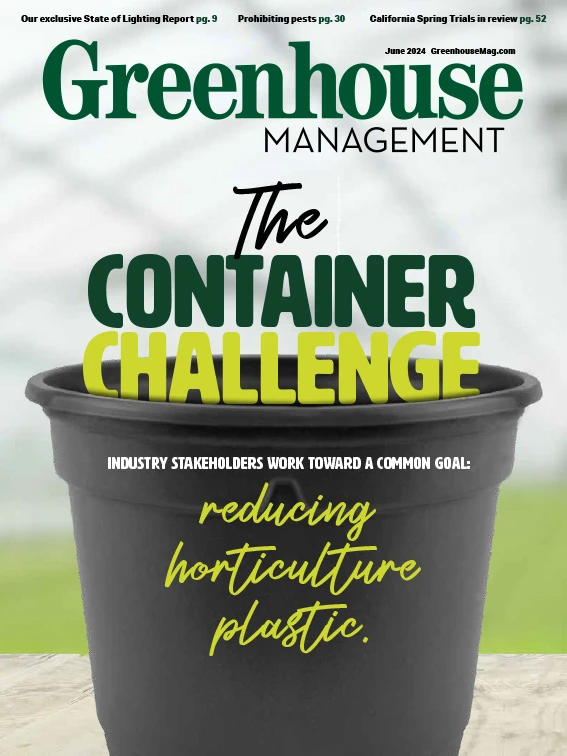
Using resources efficiently is a central tenet of greenhouse crop production, and it applies to every resource — from time, money and space to water and fertilizer. Plant growth regulators (PGRs) are no exception. One way to increase efficiency with PGR use is through tank mixes. By combining one or more active ingredients (tank mixing), you create a solution containing multiple active ingredients (tank mix). There are several reasons why tank mixes are useful in containerized greenhouse crop production — the primary ones being enhanced activity and labor savings. But there are a few guidelines you’ll want to follow, as well.
First, why are you tank mixing? Some growers will use a tank mix to get synergistic effects, and this is most common with controlling plant size. Growth retardants are one of the most common PGRs applied to containerized plants. The majority of growth-retarding PGRs work by inhibiting gibberellic acid synthesis — but their site of activity varies, and this is a very important point when combining GA synthesis inhibitors. The GA inhibitors can be classified into one of three basic sites of activity.
1) Chlormequat chloride inhibits the conversion of geranylgeranyl pyrophosphate to copalyl pyrophosphate and subsequently to ent-kaurene.
2) Ancymidol, flurprimidol, paclobutrazol and uniconazole (“the triazoles”) all inhibit the conversion of ent-kaurene to ent-kaurenoic acid.
3) Daminozide inhibits the conversion into several different versions of GA at the end of the pathway.
It is important to note that while ethephon does inhibit excessive growth, it does so through an ethylene-mediated effect, not GA inhibition. While there won’t be a quiz on this, it is important to remember when tank mixing GA inhibitors because selecting active ingredients with different sites of action is how we get synergistic effects. If we were to select two active ingredients that had the same site of activity, like flurprimidol and paclobutrazol, there would be no synergistic activity — it would be just like using a higher concentration of one of them.

Sometimes, tank mixes are not made for synergistic effects, as we just discussed with GA inhibitors. Rather, tank mixes with active ingredients having complementary effects on crops can be made. For instance, a GA-inhibiting growth retardant may be mixed with a branch-promoter like benzyladenine, with the goals of controlling unwanted elongation while promoting branching. Perhaps you want to combine benzyladenine (BA) with ethephon to really enhance branching (from both active ingredients), as well as aborting unwanted premature flower buds and some growth control (ethephon). Maybe you want to combine daminozide with ethephon for controlling growth, aborting flowers and enhancing branching early in production. By mixing active ingredients with a variety of effects, it ultimately saves labor from making multiple applications and reduces the time that re-entry intervals keep employees out of the greenhouse.
Another important piece of information to know is how the active ingredients in your tank mix are taken up by plants, since this directly affects what application method you can use. All PGRs are taken up by shoots, either leaves or stems. This means that any PGR or PGR tank mix can be applied as a foliar spray. Although all PGR combos can be applied as a spray, keep in mind the volume of spray solution that should be applied. The standard volume of PGR solution to apply is 2 quarts per 100 square feet. Sometimes, applying a higher volume of solution can have excellent effects, as is the case with foliar auxin applications applied at up to 4 or 6 quarts per 100 square feet. Alternatively, less than 2 quarts of solution per 100 square feet should be applied for some active ingredients. For example, some chemicals such as ethephon and BA+GA can have adverse effects on the root growth and development of cuttings from the excess runoff of sprays, and lower solution volumes help avoid this. Although all PGRs are taken up by shoots, not all PGRs are taken up by roots (or labeled for rootzone applications), though many are. Notable PGRs that should not be applied to the rootzone due to inactivity and/or labeling include daminozide and chlormequat.
When tank mixing active ingredients, there are several precautions that must be taken to find success. First, be sure that materials are compatible in the tank. A little trialing with mixing will help confirm the compatibility of active ingredients prior to mixing on a large scale. In addition to making sure the different active ingredients are compatible to mix, it is essential to know the combination won't damage plants. Conduct small-scale trials in-house to see if the tank mix causes any adverse effects on crops, such as phytotoxicity.
Although the number of possible tank mixes of PGRs is not quite endless, there are certainly unique possibilities that exist. Using PGRs — and utilizing tank mixes to apply them — are another opportunity to fine-tune your approach to production, including crop quality and labor efficiency.

Explore the June 2024 Issue
Check out more from this issue and find your next story to read.
Latest from Greenhouse Management
- The Growth Industry Episode 3: Across the Pond with Neville Stein
- A nation of gardeners: A history of the British horticulture industry
- How Izel Native Plants is solving the native plant conundrum
- Trends: Proven Winners 2025 perennial survey shows strong demand
- Online registration opens for 2025 Farwest Show
- Cashing in with customization
- The Ball Seed Difference
- Lawsuit challenges new H-2 visa rules





